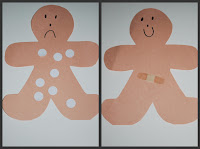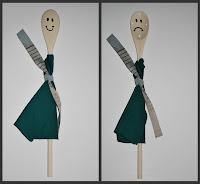I knew that we would focus this week on Parshat Kedoshim (lots of nice sweet mitzvot) and not Achrei Mot (the Azazel-goat). First I selected a handful of the most accessible mitzvot in the parsha - respecting elders, respecting parents, not speaking lashon hara, loving your neighbor, etc. (cleverly omitting the prohibitions again incest and child slaughter) - to review and discuss. Originally, I thought that we would make a "mitzvah tree" so that we could keep track of when we fulfilled any one of these. I nixed that because they (and every other Jewish preschool) have a mitzvah tree at school and I generally try to avoid having the walls of my home look too much like a preschool bulletin board. So, my revised idea was to create a "mitzvah jar." If you google "mitzvah jar" (which I did), you will find many ideas for Bar Mitzvah favors - jars filled with jelly beans customized with slogans like "I partied at Justin's bar mitzvah" - this is not what I was looking for.
There was only one that was relevant to my project - a facebook group - this is the description of the group:
“Mitzvah” means good deed, in Hebrew. When my children were very young, one and three years old, we began using what we called a “Mitzvah Jar” to encourage good behavior. When a good deed was done, we’d write it down on a piece of paper, fold it up, and put it in the Mitzvah Jar. Every so often, we’d take all the pieces of paper out and read them, to remind us of all the good they’d done. Reading all the good deeds was inspirational, no matter how simple the nice gesture was (one of my favorites…“Zachary helped Joshua open the refrigerator”), and motivated the whole family to be kind and helpful to others. Let’s take helping others to a new level! Share your acts of kindness and let’s inspire each other to make a difference! Do it in groups, do it alone, something big, something small. If you have an idea but need more manpower, post it! Who knows? Maybe through this group you'll connect with people in your area that would like to be a part of your project! Let's inspire and be inspired!
I don't know who Sue Naiditch Mirman is but this is just what I had in mind so a "mitzvah jar" it was. No shopping required. In my endless and futile attempts to have my home look like the Container Store, I have plenty of extra storage jars for dried goods.
First, I found lots of fun "google images" to represent the mitzvot we were discussing like:



Then, we got to work coloring, cutting, and pasting.
Avital decided to cut something other than paper - her hair!!!! - when I wasn't looking... but that is for another blog...
Our finished project is not gorgeous but it sits next to our shabbat candles and will hopefully gradually fill up with "mitzvah notes." On Friday, we put in the following notes:
"Maya helped her teacher do the dishes"
"Avital listened to her imma and left her bag in the car"
"Imma helped a friend cook Shabbat dinner"
While I like this project, I am somewhat wary of becoming the overly enthusiastic mother who is constantly saying in a sing-song voice things like "Who wants to be a mitzvah girl?" and "Someone did a mitzvah!". You can take the girl out of yeshiva, but...

